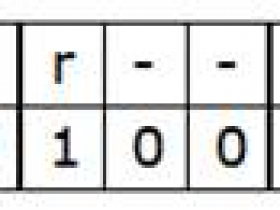- A+
【Linux基础】shell编程(一) 变量
什么是shell编程
简单的命令可以在命令行中直接输入,但是复杂的命令需要写在脚本里。例如一个简单的shell脚本:
#!/bin/bash #输出一行 echo "Hello World!" #开始的行是注释行,空行会被忽略。
如何运行shell脚本
-
方式一:直接输入脚本的相对路径或绝对路径
./run.sh- 需要给shell脚本添加可执行权限,否则会报错:Permission denied
-
方式二:sh+脚本的相对路径或绝对路径
sh ./run.sh- 不需要添加可执行权限
第一行 #!/bin/bash
第一行叫什么?
WHAT IS THIS LINE CALLED?
This first line (#!/bin/bash or #!/bin/sh) has a name. It is known as ‘she-bang‘(shabang). This derives from the concatenation of the tokens sharp (#) and bang (!). It is also called as sh-bang, hashbang, poundbang or hash-pling. In computing, a she-bang is the character sequence consisting of the characters number sign and exclamation mark (#!) at the beginning of a script.
shabang,由sharp(#)和bang(!)组合而来,必须位于一个脚本的第一行
为什么要加这个,有什么用?
In Unix-like Operating Systems when a script starting with a she-bang(#!) is executed as a program, the program loader parses the rest of the script’s initial line as a interpreter-directive. Thus the specified interpreter program is run instead, passing to it as an argument the path that was used initially through the script.
In simple words, the she-bang at the head of the script tells the system that this file is a set of commands to be fed to the command interpreter indicated. Unix-like operating systems has variety of shells and each of script header lines call a different command interpreter.
如果shell看到第一行是shabang,shell就知道这个文件是一个shell脚本,并按照shabang的指引到/bin/bash找到指定的shell解释器,然后把文件中的命令传给shell。
解释器可以是bash,也可以是csh等等。
SOME she-bang EXAMPLES
*#!/bin/sh :Executes the script using the Bourne shell or a compatible shell, with path /bin/sh*
*#!/bin/bash :Executes the script using the Bash shell.*
*#!/bin/csh -f :Executes the script using C shell or a compatible shell.*
*#!/usr/bin/perl -T :Executes the script using perl with the option of taint checks*
*#!/usr/bin/env python :Executes the script using python by looking up the path to the python interpreter automatically from the environment variables*
shell的变量
变量的赋值和使用
#!/bin/bash #将一个字符串赋给变量A LOG="monday" echo "The value of logfile is:" #美元符号用于变量替换 echo $LOG 运行结果:
$ sh ./variable.sh The value of logfile is: monday -
变量的赋值:
- 变量赋值时,等号两边都不能打空格
- 变量名可以由字母、数字和下划线组成,但是不能以数字开头
- 变量名称一般为大写(代码规范,不是语法要求)
-
变量的使用:
- 当需要使用变量时,要用
$对变量进行替换。BASH中,美元符号$用于对一个变量进行解析,shell在碰到$引导的变量时,会自动将其换成这个变量的值。
- 当需要使用变量时,要用
-
变量作用范围
-
变量只在其所在脚本有效。
-
source可以强行让一个脚本影响其父环境
-
$ source variable.sh The value of logfile is: monday $ echo $LOG monday
-
-
与之相反,export可以让脚本影响其子shell环境
-
$ export count=5 ##输出变量count $ bash ##启动子shell $ echo $count 5 $ exit ##回到先前的shell中 exit
-
-
使用unset可以注销变量
-
unset log
-
-
变量替换
-
$用于解析变量,如果要输出这个符号,需要使用转义字符''
-
$ LOG='Monday' $ echo
-
-
shell提供了花括号"{}"来限定一个变量的开始和结束。当需要紧跟变量输出字母后缀时,必须使用这个功能
-
$ WORD='big' $ echo "This apple is ${WORD}ger" This apple is bigger
-
位置变量
可以向shell脚本传命令行参数,shell脚本中使用以数字命名的变量来存放这些参数,称为位置变量。
-
简单地说,第一个位置变量存放在
$1,第二个存放在$2,以此类推。当变量数量超过10个时,需要加花括号把数字括起来。例如${10},${23}等。 -
$0用于存放脚本自己的名字。
!#/bin/bash echo "$0 = *$0*" echo "$1 = *$1*" echo "$2 = *$2*" echo "$3 = *$3*" 运行结果:
$ sh ./diaplay_para.sh first second $0 = *display_para.sh* $1 = *firsh* $2 = *second* $3 = ** ##不存在第三个变量,所以为空 除了以数字命名的变量外,shell还提供了另外三个位置变量:
- $*:包含参数列表
- $@:包含参数列表,同上
- $#:包含参数的个数
#!/bin/bash #显示有多少个参数需要列出 echo "The number of parameter is $#" for para in $@ do echo $para ##也可以写成 echo "$para" done 运行结果:
$ sh ./list_para.sh first second The number of parameter is 2 first second BASH引号规则
shell脚本中可以使用的引号有以下三种:
- 双引号:阻止Shell对大多数特殊字符(例如#)进行解释。但
$、`和"仍然保持其特殊含义 - 单引号:阻止Shell对所有字符进行解释
- 倒引号:
`,这个符号通常位于键盘Esc键的下方。当用倒引号括起一个Shell命令时,命令会被执行,并将执行后的结果作为表达式的值。
#!/bin/bash LOG=Saturday echo "Today is $LOG" echo 'Today is $LOG' echo "Today is `date`" echo 'Today is `date`' 运行结果:
Today is Saturday Today is $LOG Today is Thu Jun 8 17:37:43 CST 2023 Today is `date` 小结
- 运行Shell脚本:sh+脚本的相对路径或绝对路径。
- 第一行的"#!/bin/bash"是shabang(sharp bang),表明Shell解释器的路径。有Shabang的文件运行时会被自动识别成Shell脚本。
- 变量赋值时,等号两边不能有空格。
- $符号后面的变量会被自动替换成变量的值。
- 数字命名的变量表示传入的位置变量,如($1), (${12})。($@)和($*)表示位置变量列表,($#)表示位置变量的数量。
- 双引号阻止大多数字符解析,单引号阻止所有字符解析,倒引号执行命令并作为表达式的值。




